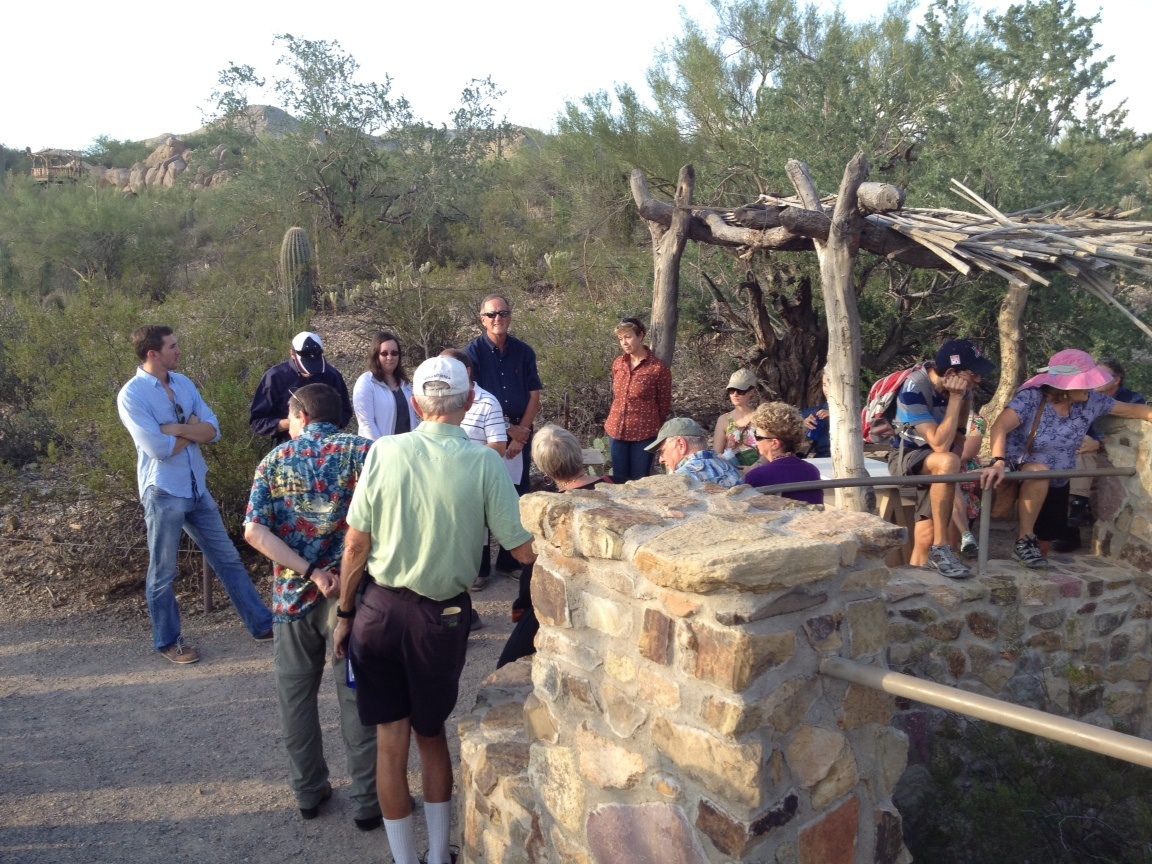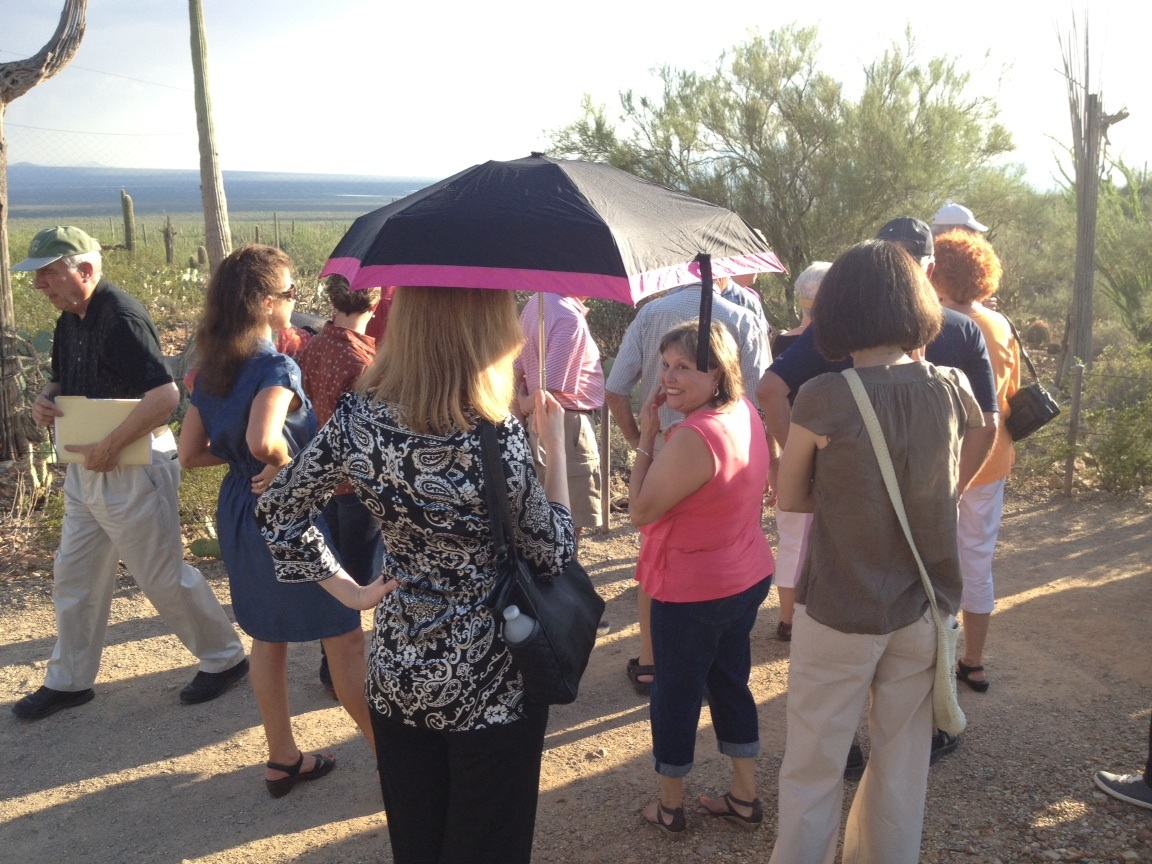By: Whitney Klotz
For this particular work function, the Wranglers and hiking boots, among other Western/outdoor wear, make an appearance. Shelved are the collared shirts, pressed slacks, and white coats. It’s the annual visit to the Arizona-Sonora Desert Museum by the Section of Infectious Diseases, University of Arizona Medical Center.
 The Arizona-Sonora Desert Museum (ASDM) sits about 20 miles west of Tucson. It’s an impressive institution, with exhibits dotting 21 acres of desert land, and its collections consisting of living plants and animals native to the Sonoran Desert Region, including the ugly but lovable javelina. As a good portion of the wildlife is most active during the evening hours, the museum holds the Summer Saturday Evening program during the months of June, July and August. With discounted admissions fees and extended hours (4 p.m. to 10 p.m.), the program gives visitors an affordable opportunity to convene with nature’s nocturnal creatures.
The Arizona-Sonora Desert Museum (ASDM) sits about 20 miles west of Tucson. It’s an impressive institution, with exhibits dotting 21 acres of desert land, and its collections consisting of living plants and animals native to the Sonoran Desert Region, including the ugly but lovable javelina. As a good portion of the wildlife is most active during the evening hours, the museum holds the Summer Saturday Evening program during the months of June, July and August. With discounted admissions fees and extended hours (4 p.m. to 10 p.m.), the program gives visitors an affordable opportunity to convene with nature’s nocturnal creatures.
The Section of Infectious Diseases-ASDM event first took place on a summer evening about six years ago and since then has become an anticipated event on the work calendars of the section’s physicians. It was an idea developed and first implemented by the former Chief of the Section of Infectious Diseases, Dr. Eskild Petersen, the current Chief of the Section, Dr. Stephen Klotz, and Professor of Clinical Pediatrics and member of Pediatric Infectious Diseases, Dr. Sean Elliott.
The event was begun by the three doctors in the hopes of fostering a strong sense of camaraderie among staff, in addition to providing an opportunity for learning. Its intended participants are the Infectious Diseases physicians and trainees, but also welcomed are physicians from other disciplines, like cardiology and pulmonology. ASDM is the place of choice for the function because, as Dr. Klotz explains, the museum is a “beautiful venue” that allows for an “unusual conference,” a “moving conference.”
 As a group, the conference participants – along with spouses, invited guests, and the occasional child (I myself tagged along a couple of times) – make their way across the museum’s expansive grounds, a journey punctuated by short but informative stops at pre-selected wildlife exhibits. At the exhibits, the physician responsible gives a lesson on how, in terms of infectious diseases, humans and the chosen animal are connected. In other words, the physician discusses a particular illness that the animal can pass along to humans. (In the medical world, these illnesses are referred to as zoonoses.)
As a group, the conference participants – along with spouses, invited guests, and the occasional child (I myself tagged along a couple of times) – make their way across the museum’s expansive grounds, a journey punctuated by short but informative stops at pre-selected wildlife exhibits. At the exhibits, the physician responsible gives a lesson on how, in terms of infectious diseases, humans and the chosen animal are connected. In other words, the physician discusses a particular illness that the animal can pass along to humans. (In the medical world, these illnesses are referred to as zoonoses.)
For example, one year, everybody gathered around the coati exhibit, eager to learn about this raccoon-like animal. The physicians were informed that coatis can cause meningitis in humans, a medical situation most common among children. Basically, roundworm eggs (Baylisascaris procyonis), found in coati excrement, find their way into the body of a child (think children playing outdoors) and then proceed to hatch. Once hatched, the roundworms infest themselves in the membranes that sheath the child’s brain and spinal cord, thus leading to a lethal case of meningitis. (This is certainly not a conference for the squeamish!)
After about a dozen or so of these lessons and the observance of a uniquely Southwestern sunset, the evening culminates in dinner at the museum’s Ocotillo Café. During their meal, the doctors have a chance to satisfy their evening cravings, reflect on the presented material, and connect with one another on both personal and professional levels. The dinner also serves as an informal graduation ceremony for the Infectious Diseases fellows (trainees) who have successfully completed their specialized medical training. The fellows receive a certificate of completion, a small gift, and a message of thanks, praise, and encouragement.
Lest you think that the conference is just a walk in the park in terms of getting it up and running (pun intended), you must know that much time and thought goes into its production. Dr. Klotz spends a good deal of time generating topics on which the doctors will present. Because there is a repeat audience, he is careful to identify topics that have yet to be discussed or that have not been discussed in quite some time. After selecting the topics, he thoughtfully assigns them to the physicians, encouraging the physicians to include a case study in their presentations, either pulled from their own experiences or from the literature. Occasionally, Dr. Klotz has physicians who come up with their own topics.
Once the topics have been identified and assigned, Dr. Elliott works up an itinerary for the conference, ensuring that the evening isn’t spent zig-zagging across the grounds. He creates a program that logically moves the participants from one wildlife exhibit to the next. And, during the conference, Dr. Elliott takes on the difficult role of timekeeper. He helps presenters stay within their allotted ten minutes so that come 7:00 p.m. or so, everyone is enjoying a cool drink at the café, having enjoyed a light but valuable evening of education.
Hopefully, this post has provided a nice, bite-sized example of how informal learning institutions are useful and meaningful to the communities in which they operate. If you ever happen to find yourself in the Tucson community, I strongly recommend heading out to the Arizona-Sonora Desert Museum, especially if you can do so on a summer evening. It’s really a delightful place and, simply put, there is nothing like the desert at night. Be sure to rent a black light from the museum and check out the glow-in-the-dark scorpions traversing the grounds. You’ll be shocked, and maybe a little frightened, at just how many there are!








Comments
The arizona desert museum is a must do in the tucson area! Go when you are in the area!
Add new comment